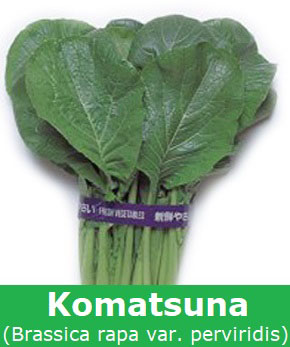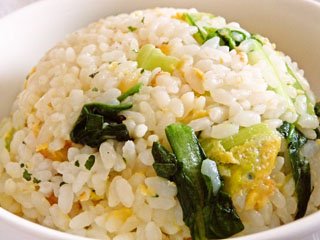Komatsuna Nutrition facts
Komatsuna (コマツナ) or Japanese mustard spinach is a nutritious green-leafy vegetable widely used in Japan, Korea, and Taiwan.
Komatsuna is a cool-season crop in the Brassicaceae family vegetables, which also includes mustard greens, cabbage, broccoli rabe, and turnips. The also known by Japanese spinach in the west.
Scientific name: Brassica rapa var. perviridis.
 |
Komatsuna is quick growing, upright plant. It prefers cool climates supplemented by well-drained, fertile soil to flourish.
Young plants of komatsuna are sensitive to hot summers and therefore, sow seeds in late spring after the last frost or early fall for best results. Harvesting may be done in 10-15 days for microgreens; 30-50 days full mature greens. Generally, farmers harvest leaves and young stems when the plant is about 8-10 inches tall.
Fresh komatsuna leaves are described as broad, oval, smooth, deep green with a flat surface and may have smooth edges depending on the cultivar type.
Cool-season hybrids cultivars are:-
Traditional Komatsuna.
Green boy variety: This mild-flavored cultivar has tender deep green leaves, sturdy petioles. Japanese growers prefer it because of its cold tolerance and can be grown year-round in cool areas.
However, some of komatsuna hybrid varieties that tolerate hot summers include:-
Red leaf Komatsuna: It is an excellent choice for baby leaf greens. It can also be used for microgreens. The leaf coloring is distinct- purplish-red on the top and green with red veins underneath. The tender leaves are round and relatively flat, growing uniformly from bright green upright stems and will retain their deep purple color in cooking.
Summer Fest Hybrid: This popular traditional Japanese komatsuna hybrid is especially suited for summer crops and high tolerance to multiple diseases. It has glossy, thick dark green leaves and an upright growing habit.
Senposai: This fast-growing vegetable is a hybrid of cabbage and komatsuna. It has the sweet taste of cabbage and the tenderness of komatsuna. Senposai is heat tolerant and grows well in different climates all year round.
Komatsuna Health benefits
Komatsuna leaves and stems are the storehouse of numerous phytonutrients that have health promotional and disease prevention properties.
It is very low in calories (22 calories per 100 g raw leaves) and fats. Nonetheless, its dark-green leaves carry plenty of antioxidants, vitamins, and minerals.
Komatsuna greens are a good source of dietary fiber. Studies suggest that sufficient amount of soluble and insoluble fibers in the diet helps control cholesterol levels through interfering its absorption in the gut. The fiber-rich diet also facilitates smooth bowel movements, and thereby, eases constipation as well offers some protection against hemorrhoids, and colon cancer.
Komatsuna are a rich source of antioxidants like flavonoids, indoles, sulforaphane, carotenes, lutein, and zeaxanthin. Indoles, mainly Di-indolyl-methane (DIM) and sulforaphane have proven benefits against prostate, breast, colon and ovarian cancers by virtue of their cancer-cell growth inhibition, cytotoxic effects on cancer cells.
Fresh leaves are excellent sources of folates and pyridoxine. 3.5 Oz (100 g) raw komatsuna carries 159 μg or 40% daily recommeneded levels of folates. Folates in the diet help improve anemia and play a role in prevention of the neural-tube defects in newborn babies.
The greens are also a moderate sources of other B-complex group of vitamins such as, thiamin, riboflavin, niacin, pantothenic acid, etc. Many of them paly a pivotal role as cofactos in the substrate metabolism inside the human body.
Fresh Japanese mustard leaves are excellent sources of vitamin-C. 3.5 Oz (100 g) fresh leaves provide 130 mg or about 144% of RDA. Vitamin-C (ascorbic acid) is a powerful natural antioxidant that offers protection against free radical injury and flu-like viral infections.
Komatsuna leaves are also incredible sources of vitamin-A (provide 9900 IU or 330% of RDA per 3.5 Oz (100 g). Vitamin-A is an essential nutrient required for maintaining healthy mucosa, hair and skin. Consumption of natural foods rich in flavonoids helps protect from lung and oral cavity cancers.
The greens are excellent sources of vitamin-K. Vitamin-K has been found to have a potential role in bone mass building function by promoting osteoblastic activity in the bone. It also has an established role to play in Alzheimer's disease patients by limiting neuronal damage in their brain.
Fresh Komatsuna are an excellent source of several essential minerals such as calcium 210 mg (21% RDA), iron (19% RDA), magnesium, potassium, zinc, selenium, and manganese (18% RDA).
Regular consumption of Komatsuna in the diet is known to prevent arthritis, osteoporosis, iron deficiency anemia and believed to offer protection from cardiovascular diseases, asthma, and colon and prostate cancers.
| Principle | Nutrient Value | Percent of RDA |
|---|---|---|
| Energy | 22 Kcal | 1% |
| Carbohydrates | 3.9 g | 3% |
| Protein | 2.2 g | 4% |
| Total Fat | 0.3 g | 1.5% |
| Cholesterol | 0 mg | 0% |
| Dietary Fiber | 2.8 g | 7% |
| Vitamins | ||
| Folates | 159 μg | 40% |
| Niacin | 0.678 mg | 4% |
| Pantothenic acid | 0.178 mg | 3.5% |
| Pyridoxine | 0.153 mg | 12% |
| Riboflavin | 0.093 mg | 7% |
| Thiamin | 0.068 mg | 7% |
| Vitamin A | 9900 IU | 330% |
| Vitamin C | 130 mg | 144% |
| Electrolytes | ||
| Sodium | 21 mg | 1.4% |
| Potassium | 449 mg | 9.5% |
| Minerals | ||
| Calcium | 210 mg | 21% |
| Copper | 0.075 mg | 8% |
| Iron | 1.5 mg | 19% |
| Magnesium | 11 mg | 3% |
| Manganese | 0.407 mg | 18% |
| Selenium | 0.8 µg | 1.5% |
| Zinc | 0.17 mg | 1.5% |
Selection and storage
Komatsuna can be harvested at any stage- from microgreens to flowering tops. While young, its leaves have a mild flavor and are prepared much like spinach. As the plant grows, the stems become tougher, and flavor grows stronger and hotter, and hence, require a longer cooking time.
In the market, look for fresh greens featuring crispy, dark green leaves. Avoid wilt, spotted, or discolored leaves.
At home, keep the leaves in the refrigerator soon after buying as they wither soon if kept at room temperature.
Although they can be stored for up to 3 days in cold storage, fresh komatsuna greens should be used as soon as possible to get benefits.
Preparation and serving methods
Komatsuna is a popular green-leafy vegetable in the Japanese diet. Fresh leaves, flower buds, and stems are used in a variety of cuisines all over East-Asia.
Before cooking, wash the leaves thoroughly in clean running water to remove sand/dirt and then rinse in saline water for about 30 minutes to remove any insecticide residues. Trim away thick petioles and stems.
Here are some serving tips:
 |
| Fried rice with eggs and Komatsuna. Courtesy: Kakei.R |
Fresh tender Japanese mustard-spinach greens are eaten raw either as a salad or enjoyed juiced.
Prepare simple fried rice with eggs and Japanese mustard spinach (小松菜の炒飯).
In Japan, mature komatsuna leaves are steam-cooked alone or mixed with other greens such as spinach in ohitashi. Boiled greens seasoned with dried bonito flakes, sesame seeds, and soy sauce broth as a dressing to flavor and to tame the pungent, peppery flavor.
Use in dashi-soups mixing with chicken, mushroom, and chopped green onions.
Komatsuna can be substituted for napa (Chinese) cabbage for a more highly flavored version of kimchee.
Safety profile
Reheating of Japanese spinach leftovers may cause conversion of nitrates to nitrites and nitrosamines by certain bacteria that thrive on prepared nitrate-rich foods, such as komatsuna, spinach, and many other green vegetables. These poisonous compounds may prove harmful to health.
Phytates and dietary fiber present in the komatsuna may interfere with the bioavailability of iron, calcium, and magnesium.
Komatsuna, being a Brassica family vegetable, contains oxalic acid, a naturally occurring substance found in some vegetables which may crystallize as oxalate stones in the urinary tract in some people. People with known oxalate urinary tract stones are advised to avoid eating vegetables belong to the Brassica family. Adequate intake of water is, therefore, necessary to maintain normal urine output.
Komatsuna may also contain goitrogens which may interfere with thyroid hormone production and can cause thyroxin hormone deficiency in individuals with thyroid dysfunction.
(Medical Disclaimer: The information and reference guides on this website are intended solely for the general information of the reader. It is not to be used to diagnose health problems or for treatment purposes. It is not a substitute for medical care provided by a licensed and qualified health professional. Please consult your health care provider for any advice on medications.)
You may also like to read ≻≻
≺≺ Mizuna Nutrition facts.
≺≺ Broccoli rabe Health benefits.
≺≺ Chinese broccoli (Gai lan) Health benefits.
≺≺ Tatsoi (spoon mustard) Health benefits.
≺≺ Mustard-greens Health benefits.
≺≺ Back to Vegetables from Komatsuna. Visit here for an impressive list of vegetables with complete illustrations of their nutrition facts and health benefits.
≺≺ Back to Home page.
Further reading:
Refer Stanford School of Medicine Cancer information Page- Nutrition to Reduce Cancer Risk (Link opens in new window).
Kitazawa Seed Company (Link opens in new window).
Specialty Produce (Link opens in new window).